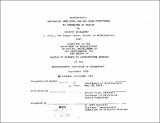| dc.contributor.advisor | Waclaw Piotr Zalewski. | en_US |
| dc.contributor.author | Guillermo, Ricardo | en_US |
| dc.contributor.other | Massachusetts Institute of Technology. Dept. of Architecture. | en_US |
| dc.date.accessioned | 2012-10-26T17:58:12Z | |
| dc.date.available | 2012-10-26T17:58:12Z | |
| dc.date.copyright | 1982 | en_US |
| dc.date.issued | 1982 | en_US |
| dc.identifier.uri | http://hdl.handle.net/1721.1/74300 | |
| dc.description | Thesis (M. Arch.)--Massachusetts Institute of Technology, Dept. of Architecture, 1982. | en_US |
| dc.description | MICROFICHE COPY AVAILABLE IN ARCHIVES AND ROTCH. | en_US |
| dc.description | Includes bibliographical references. | en_US |
| dc.description.abstract | There are many reasons for undertaking a work such as this. Among them are the benefits offered to society when we acknowledge the potential of submersible structures, The provision of habitable underwater space remains an unexploited resource of great potential. Hopefully, it will be utilized in an ethically intelligent manner. Perhaps, the spiritual qualities of water will foster peace engendering or life sustaining pursuits resulting in paradigms of new urban forms and ideals. Herein, a broad view is offered of inspirations and ideologies leading towards a conceptual basis for sea dwellings. Developed from an ontogenesis into criteria for environmental design, siting, energy options and program ethics, a platform for establishing a sea utilization framework is imparted. The structural design development incorporates fundamental considerations for aqueous habitats. Reinforced concrete for sea use is discussed in depth including expositions on hydraulic cements and construction techniques . A basic sea structure design/analysis method which uses thin shell theory to reliably approximate the behavior of thick shells is presented through both simple and complex examples. The volume concludes with a metamorphosis of sea dwelling concepts in the form of original sketches, technical drawings and tone paintings. This thesis attempts to broaden the scope of knowledge of the architectural designer and planner through an effort to bridge ocean sciences, ocean engineering and architectural concerns. With the knowledge thus gained, it may be possible to project further into civilization's potential for cultural development within the limited context of the sea as a dwelling place. | en_US |
| dc.description.statementofresponsibility | by Ricardo Guillermo. | en_US |
| dc.format.extent | 282 p. | en_US |
| dc.language.iso | eng | en_US |
| dc.publisher | Massachusetts Institute of Technology | en_US |
| dc.rights | M.I.T. theses are protected by
copyright. They may be viewed from this source for any purpose, but
reproduction or distribution in any format is prohibited without written
permission. See provided URL for inquiries about permission. | en_US |
| dc.rights.uri | http://dspace.mit.edu/handle/1721.1/7582 | en_US |
| dc.subject | Architecture. | en_US |
| dc.subject.lcsh | Underwater construction | en_US |
| dc.subject.lcsh | Underwater concrete construction | en_US |
| dc.subject.lcsh | Architecture, Domestic Designs and plans | en_US |
| dc.title | Aquatecture : underwater dwellings and sea born structures as paradigms of design | en_US |
| dc.title.alternative | Underwater dwellings and sea born structures as paradigms of design | en_US |
| dc.type | Thesis | en_US |
| dc.description.degree | M.Arch. | en_US |
| dc.contributor.department | Massachusetts Institute of Technology. Department of Architecture | |
| dc.identifier.oclc | 09343419 | en_US |
